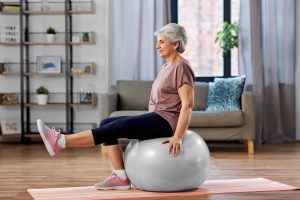Our bodies change as we age. Our joints stiffen, we lose bone density and flexibility, and even our vocal cords tend to thin out, stiffen and shrink, resulting in a breathier, quieter voice.
While it might be tempting to stay inside watching your favorite TV show, especially during the colder months, it’s crucial for everyone to maintain their mobility and flexibility, especially as they age. When you were 18 you might have been able to lounge around for a week and then jump out of bed to run 5 miles without breaking a sweat, but those days are long gone. This doesn’t mean that you aren’t able to have a vibrant, active life (or run 5 miles – although you might sweat a bit more at this point in your life), it just means that you need to put more effort into consistency, as it’s easy to loss muscle mass and flexibility as you age, and takes a lot longer to build up strength or recover from an injury when you are more advanced in years. Of course, in an ideal world everyone would stretch and exercise every day, but when you’re younger you don’t really notice negative impacts from not doing so…that’s not the case when you’re older.
Thankfully, regular exercise and stretching can make a major difference for older adults. Many people who remain active are still able to do challenging movements, run errands, pick up their grandkids, garden, have enjoyable sex and live independent lives. All of which are pretty good reasons to want to establish a healthy stretching and exercise routine.
And, in addition to all the great benefits that staying active can bring you, it’s also very important in terms of helping you to minimize the risk of developing type 2 diabetes, stroke, heart conditions, obesity and a variety of other health conditions, as outlined on Medline Plus. Of course, it’s worth pointing out that even if you exercise every day, sleep well and eat a healthy diet, you could still end up with a number of health conditions. However, maintaining healthy habits can significantly reduce your risk, and can also give you a better chance of handling your health conditions should you develop them.
Before we get into specific mobility and flexibility exercises that you should do, let’s talk a little bit about how much exercise you should get, and a few ideas for what kind of activities you might want to get involved in.
Mayo Clinic tells us that we should aim to get a minimum of 150 minutes of moderate activity a week, 75 minutes of vigorous activity or a mix of both. And that recommendation is a minimum. Unless you’re pushing yourself towards dangerous levels of exertion, there’s usually not a strict upper limit on how much activity you should get.
You should aim to spread out your physical activity throughout the week, and mix up the kind of exercise you do. Aerobic exercise helps to improve your cardiovascular health, improving your circulation and lowering blood pressure and cholesterol levels. Resistance training is important for building muscle and bone density, improving balance and increasing your metabolism. All forms of exercise can help boost immune health as well as your mental health.
In terms of what constitutes moderate versus vigorous activity? First of all, let’s get into what differences you will experience between them.
With moderate activity you can expect that your heart rate will rise and you may break a sweat, but you should still be able to hold a conversation without much effort.
Vigorous activity will probably push your heart rate even higher, you’ll be breathing hard, and you’ll probably find it hard to say more than a word or two without stopping to catch your breath.
As for what kind of activity you should do? Well, that really depends on…you. Everybody has a different fitness background and what might be easy for you might be hard for another person. For example, walking might be considered a moderate activity to some, but to others, who spend a lot of time at home and are not often active, it might be much more difficult and be labeled a vigorous activity. And if you regularly work out then your fitness will improve, so if walking was initially difficult, it may now feel moderate to you.

- Walking
- Cycling
- Water aerobics
- Pickleball
- Gardening
- Yoga
And in terms of vigorous activity you might be looking at:
- Swimming
- Jogging
- Dance
When thinking about what kind of exercise to incorporate into your lifestyle one of the most important things to consider is whether or not you enjoy that activity. Enjoyment makes it more likely that you will want to continue doing that activity, so experiment until you find something that you love. Socialization can also be a good motivator, so invite friends and family to join you for a walk or to go to a Zumba class.
Now that we’ve talked about the importance of exercise, let’s focus in on what mobility and flexibility means, and the exercises you can incorporate into your daily routine to keep your body healthy.
Royal City Physio goes into detail with both definitions, but we’ll offer up a shortened version.
Flexibility is the ability of a muscle to stretch and lengthen. Think of an elastic band, when it’s new it’s soft and flexible, but over time, if left unattended to, it can grow stiff and snap if stretched. Humans aren’t elastic bands, but if we don’t stretch our muscles they can become stiff and immobile.
Mobility is when a joint is able to go through its entire range of motion. Think of bending your arm or spinning it in circles. Although mobility requires healthy joints, flexibility also plays a key part as well, so you can’t really have one without the other.
Many forms of activity can support flexibility and mobility, such as yoga or pilates. But, if you live a sedentary lifestyle, or are doing a lot of vigorous activity without proper rest and stretching, then you might limit the ability of your muscles and joints to relax and operate to their fullest extent. This can cause problems such as pain or difficulty doing simple tasks like getting up and down from a seated position or bending over to pick something up. So, let’s look at some exercises you can build into your routine to increase your flexibility and mobility. You might do some of these exercises before and after a workout, or put aside some time during the day, perhaps with some meditation and journaling, to give yourself some well deserved “me time.” Let’s start with flexibility exercises.
When stretching only hold the pose to the point where you feel a slight pull in the targeted area. Hold each stretch for around 30 seconds, and don’t continue if you feel pain. There are generally always alternative stretches you can do. If you are constantly feeling pain then you should visit your doctor or a physiotherapist.
Hip Flexor and Thigh
This stretch targets your hip flexor, which is where your leg meets your torso, as well as your thigh – the upper part of your leg.
- Stand close to a wall or a sturdy object like a table you can use for support if needed.
- Try to stand straight.
- Lift the heel of your right foot and continue lifting as though trying to touch your own bum.
- Grab that foot with your right hand and hold.
- Once you’ve held the stretch for 30 seconds, switch to the other side.
Calf Stretch
The calf is the area in the back of your lower leg. It can often feel tight from exercise or simply being on your feet a lot. There are a few different ways to perform a calf stretch. Try them out to see what works best for you.
Version 1:
- Stand close to a wall and place both hands against it as though trying to push through it.
- Gently bend your right knee while moving your left leg straight out behind you.
- You should feel the stretch in your left leg. You can adjust the stretch with how far you are from the wall, how bent your right leg is, or how far back you place your left leg.
- Switch positions to stretch your other leg.
Version 1:
- Stand close to a wall, touching it for support if needed.
- Place the toes of your right leg against the wall, while keeping your heel on the ground. Your foot will create an angle with the wall. You can adjust how much of a stretch you get with the angle.
- Complete on the other side.
You can also purchase calf stretchers which are slanted devices that you stand on. Although it’s always a good idea to consult a medical professional before investing in anything to make sure it’s the right choice for you.
Shoulder Stretch
- Hold out your right arm straight in front of you, then cross it against your chest.
- Bend your left arm and cradle your right arm into the crease of your elbow.
- Use your left arm to gently pull your right arm closer to your chest.
- Complete on the other side.
There are many other stretches for areas such as the hamstrings. Mayo Clinic offers some great advice. Of course you should always stretch out any areas that feel stiff, but it’s good to stretch every area of your body, regardless of whether you feel you need to or not. Think of it as taking your body through a regular maintenance check like you would your car. Everything might be in good working order, but it’s important to check through the mechanics and change the oil to make sure it stays that way.
Now, let’s move on to some mobility exercises.
Shoulder Circles
This might seem fairly self explanatory, but let’s go through it just in case.
- Gently raise your shoulders as though shrugging, let them drop to the back, move them to the front and then back up again – you’ve just done a circle.
- Go in one direction for 30 seconds and then reverse direction.
Arm Circles
- This is the same sort of idea as the shoulder circles but this time you hold your arms straight out to the side, as though making a giant T with your body.
- From there start tracing small circles in the air with your hands, allowing your arms to follow that movement.
- Once 30 seconds have passed you can switch direction.
- This one can be tough so be sure to take a break if you need to during this or any other exercise.
Leg Lifts
- Sit in a comfortable seat position with a straight back. Your feet should comfortably fit flat on the ground.
- Lift your right foot off the ground until your right leg is straight out in front of you. Don’t worry if your leg can’t completely straighten or get too high. Only straighten or lift to a place that’s manageable for you.
- Hold in the left position for around 5 seconds, or less if that feels too long. Repeat on the other side. You should complete the exercise around 6 times on each side.
Ankle Rolls
This exercise is similar to the shoulder or arm circles, except you’ll be moving your ankle in circles for this exercise. You can do this by:
- From a seated position in a chair, lift one foot slightly off the ground and gently roll in circles, pausing for support if needed. Be sure to switch directions.
- Switch to the other foot.
Or, if lifting the foot off the ground isn’t accessible for you, you can:
- Lie down on a yoga mat and place a rolled blanket or towel just above your ankles. You can also lie on a bed with your feet hanging off the end.
- From there you should be able to comfortably move your ankles in circles from a lying down position.
For more flexibility and mobility exercises check out this post by Health Central.
One final note is to remember to never push through an exercise that feels painful. Pain is our body’s way of telling us that something is wrong and we should stop. An exercise might feel challenging and you might feel tender, but if something is painful you should switch to a different exercise and bring up the issue to your doctor or physiotherapist at your next appointment so they can diagnose the issue and give you an alternative exercise to do. Movement is important, but if you’re pushing through pain then there’s a good chance you will injure yourself, which will make it much more difficult, if not impossible to keep up with your exercise, flexibility and mobility goals.
Stay safe, have fun, and here’s to feeling healthy and amazing!







